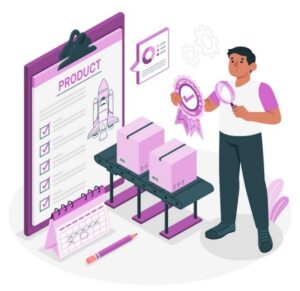Enhancing ERP Quality Control in Textile Manufacturing
Did you know that by using the right ERP software, textile companies have not only improved their day-to-day business processes, but also enhanced the quality of their products? This improvement has ultimately led to an increased customer retention rate of up to 50-70%!
But why ERP?
ERP software is one of the leading tools for textile quality management. Meeting quality demands in the textile industry leads to a significant rise in sales and helps build a strong brand reputation. However, achieving these quality standards involves navigating complex processes. Tasks like production process monitoring and managing labor-intensive operations can be challenging while maintaining a focus on quality.
This is where ERP software saves the day. The quality control module of ERP software is a crucial tool that assists in achieving your desired goals for product quality. This blog will highlight the importance of this module and explain how integrating ERP software into your textile business can ensure better quality consistency and tracking. Let’s dive in.
5 Ways ERP Enhances Quality Control
Quality control ERP systems are known for making processes efficient, and at the same time maintain the quality of procedures and the final products. Let us describe the top 5 ways an ERP software manages to get this done:

1) Minimize Human Intervention: ERP software automates processes like data entry and quality inspections to reduce room for errors that normally happen when manual procedures are involved. This translates to increased ERP quality assurance.
The ERP quality control module is programmed to help users automate quality checks. This helps to monitor parameters such as material specifications, dimensions, color consistency, and defect detection in a faster way with less opportunity for errors.
2) AI integrated Quality Checking: ERP quality control module implement AI algorithms that can analyze quality requirements of customers and predict potential quality issues before they occur. They also can predict when machineries might breakdown based on maintenance data and reports.
Features like image recognition is utilized for inspecting textile products for defects such as tears, stains, or irregular patterns. High-resolution cameras capture images of the textiles, and AI models analyze these images to detect any anomalies.
3) Increase Visibility and Data Tracking: ERP software helps users to track the movement of raw materials and finished products throughout the supply chain. This helps manufacturers to know the status of raw material purchased, orders, work output of machinery, warehousing issues, delivery issues, etc., and keep reports of all of them.
The ERP quality control module allows users to maintain dashboards that can help give a visual representation of key performance indicators (KPIs) and metrics, offering a snapshot of inventory levels, logistics and shipping metrics, employee productivity and much more.
4) Faster Problem Identification: ERP quality control module sends immediate alerts to the user when quality standards are not met, allowing for quick corrective actions. This helps manufacturers to know what issues are happening in real-time and can rectify it immediately to maintain product quality.
The software integrates with tools like IoT sensors and Machine-to-Machine (M2M) communication to report any errors that happen. The software then allows users to perform a root cause analysis to find the origin of the problem and rectify it as soon as possible.
5) Increase Customer Satisfaction: The ERP software assists users to follow all the necessary procedures to keep track of mandatory quality standards and minimize the likelihood of defects reaching customers. This in turn satisfies customer expectations of the product and help build trust with the company.
ERP systems help textile manufacturers strive for maximum customer retention. The ERP quality control module has the ability to customize the quality priorities/preferences of each customer when delivering final products. This can range from type of material used to the visual aspects such as patterns, color, finishing etc.
Benefits of Improved Quality Control with ERP
Now that we understand how ERP software enhances the quality control of a textile business, you may wonder what the tangible outcomes are. In this section, we will highlight some benefits that textile businesses experience when they improve their quality control through ERP.
- Reduced Defects and Rework: Implementing AI-integrated quality checking minimizes resource wastage, reduces errors, saves time, and lowers material costs associated with rework. This allows textile manufacturers to allocate their time and resources to other areas of the business that need improvement or rectification.
- Enhanced Process Efficiency: ERP systems send immediate alerts when there are errors or unfulfilled conditions, enabling manufacturers to rectify issues quickly and improve efficiency. This constant state of improvement increases production capacity and sales potential for the textile business.

- Improved Customer Retention: Increasing the quality of end products helps attract and retain customers. Providing quality prioritization options allows customers to be flexible with their product requirements, leading to higher satisfaction. Satisfied customers are more likely to return and continue working with the business.
- Stronger Brand Reputation: Achieving customer satisfaction not only builds a solid client base but also enhances the brand’s reputation in the textile market. A strong brand reputation based on product quality indicates to potential clients that the business can be trusted to deliver high-quality products. This opens up more opportunities to work with larger clients and scale the business further.
In conclusion, integrating ERP software for quality control in textile manufacturing is essential for maintaining high product standards, reducing errors, and enhancing efficiency. The automated processes and AI-driven quality checks ensure consistent quality and faster problem resolution, ultimately leading to increased customer satisfaction and retention. By leveraging these advanced tools, textile businesses can build a strong brand reputation and achieve sustained growth in a competitive market.

